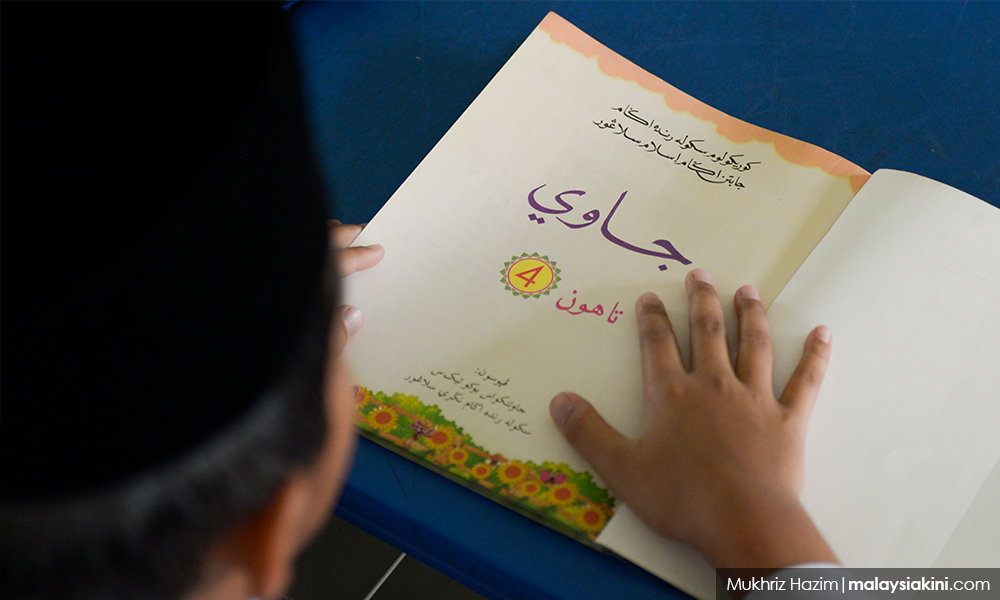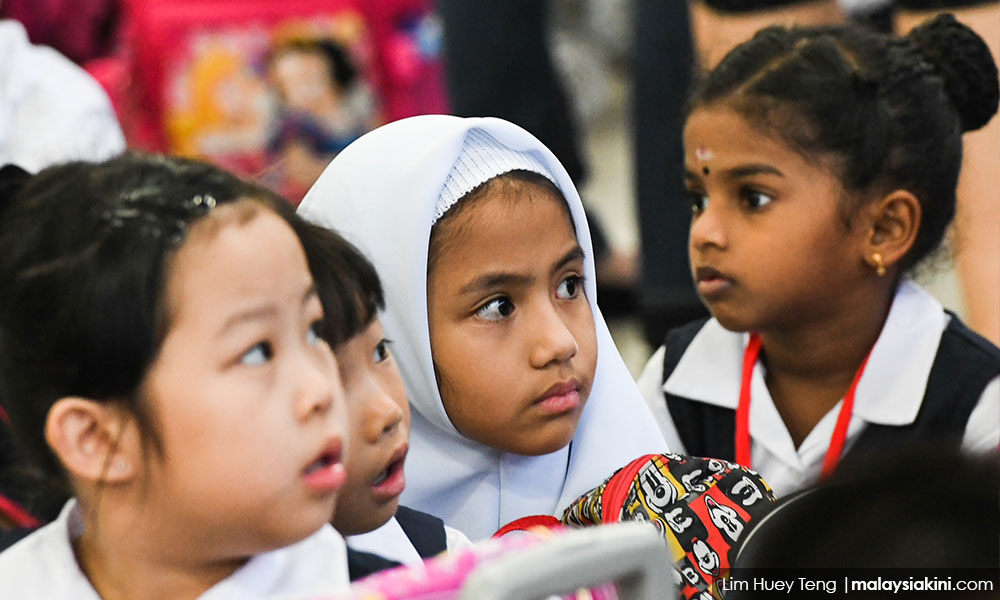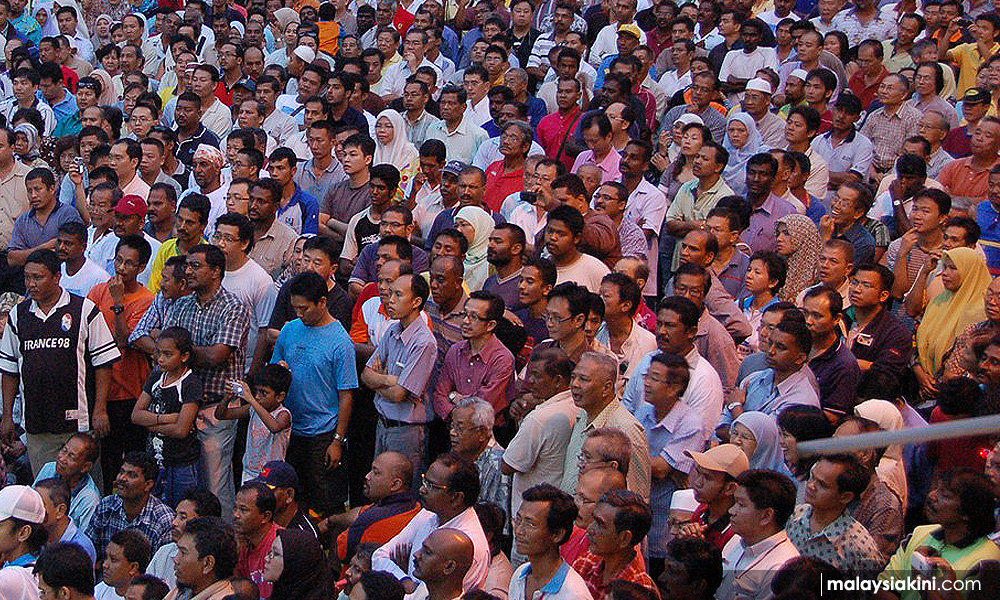COMMENT | We are shaped and guided by our life experiences. The more that we go through them, the richer our lives become. We will be less easily agitated and provoked.
That’s one of the reasons why I do not say much about the Jawi or any other communally-motivated issue, and the agitations that follow.
To me, Jawi is part of my existence. Like the shirt I wear or the food I eat. I learned to write and read Jawi the way Malays of my generation would; through the Quranic class and formal schooling at the Sekolah Melayu – the Malay School – in the 1950s and 60s.
Jawi is derived from the Arabic script with a few additional letters and was widely used for Malay language writing before the Rumi (Roman) alphabets became popular.
The Arabic script used in Malaysia, Brunei and some parts of Sumatera is known as Jawi. In Aceh, it is called Jawoe and Pattani Yawi.
To many people, Jawi is more than just a form of writing. In our part of the world, it is synonymous with the Malays and Muslims. In many instances, Jawi is used as a synonym to the Malay race.
For example, Malays of Indian Muslim descend called themselves “Jawi Peranakan”. They were products of marriages between Indian Muslim immigrants and the local Malay women.
Incidentally, this group of Malay people were among the earliest to articulate issues relating to ethnicity and statehood.
Using their mercantile wealth and better education, they started the first Malay newspaper in Singapore in 1888 called “Jawi Peranakan”.
Many old Malay texts were in Jawi. Early correspondence and agreements between the Malay rulers and the European powers were in Jawi. Jawi is an integral part of Malay history.

But Jawi was superseded by Rumi as Western-type education become widespread in the early 20thcentury. The Jawi usage is now limited to the teaching and learning of the Quran, and on signboards.
Schooling
When I started schooling in 1954 at the Sekolah Melayu Pendang (the Pendang Malay School) in Kedah, we learned both Rumi and Jawi.
Jawi formed part of the curriculum. I was acceptably good at it and can still write and read Jawi to this day but with some difficulty because the spelling system had been changed some years ago.
The Jawi-script Utusan Melayu was my basic reading until the Rumi-script Berita Harian was introduced in 1957 and Utusan Malaysia 10 years later.
I also read the Penang-based Warta Negara and the Straits Echo, the Singapore-owned Straits Times and later the Kuala Lumpur-based New Straits Times.
I remember the many hours of sheer ecstasy I had reading the lurid details of sexual relationships among the beautiful teenage model Christine Keeler, the British War Minister, Lord Profumo, and the Russian spy, Yevgeni Ivanov in the Utusan Melayu.
Thanks to my Jawi proficiency and the liberalism of the Utusan Melayu at that time – 1963 if my memory serves me right – I had many hours of excitement and gratification.
In the pre-independence days, schooling was not mandatory, and schools were few and far apart.
There wasn’t a common education system. There were the government- and church-sponsored English schools, the government-aided Sekolah Melayu, the community-built Sekolah Ra’ayat (the people’s school), the China and Tamil schools and the pondok schools.
The latter was exclusively for the teaching and learning Islamic religious knowledge. The northern states of Kedah, Penang, Perlis and Kelantan were known for their sprawling pondok communities.

The Sekolah Melayu later became Sekolah Umum (general school) and later still Sekolah Kebangsaan or the National School. The Chinese and Tamil Schools became the Sekolah Jenis Kebangsaan (National Type Schools).
English schooling
From the Sekolah Melayu Pendang, I went to the Saint Michael Primary School in Alor Setar via the Special Malay Class (SMC).
The SMC was a two-year conversion course where Malay boys and girls were converted from the Malay to English medium learning.
You can say that I don’t have problems with learning a language that isn’t my mother tongue and accepting people who are not of my race and religion.
But one of my uncles did. He was mortified upon learning that I had gone to an English school. He was certain that I would become a "kafir" in no time and pleaded with my father to take me out.
Additionally, I grew up in a multi-cultural environment. We had Chinese, Indian and Thai neighbours.
My maternal grandmother spoke the Thai dialect commonly used among the Malaysian-Thai border. Even the Malay language was heavily influenced by the Thai slang.
Our Chinese neighbours were traders and part-time farmers. Their pigs, chicken and ducks were free-ranging. We didn’t mind if the animals occasionally strayed into our compounds for as long as they didn’t dig up the ground or defecate as they liked.
We predicated the names and identities of our Chinese neighbours with the word “Cina” – Cina Ah Kow, Cina panjang (the tall Chinese), Cina ayan (the Chinese ironsmith), Cina ikan (the Chinese fishmonger) and so on.
Our Indian neighbours who were mostly barbers, cloths merchants, restaurant operators and odd-jobbers freely referred to themselves as “Keling”. The term is still commonly used in the northern states. Nothing derogatory. It had its origin in the Hindu Empire of Kalinga in India and Jawa.
Some years ago, while admiring my old former Volkswagen Beetle car in Alor Star, an Indian man approached me. He asked if I recognised him. I said sorry I did not and he happily introduced himself as “anak Keling Mydin” (the son of Mydin the Keling).
Keling Mydin was my father’s friend. He operated a coffee shop in Tanah Merah, Pendang, where our family house is located.
His daughter continues the business until today and one Keling Mydin’s sons went on to become a very senior police officer – Ayob Khan bin Mydin Pitchay – the anti-terrorism chief.
Note the “bin” in his name. Only in Malaysia a Keling could transform into a Malay or a Jawi!
Stop the slugfests
Fast forward to the 21st century and to the Chinese fear of the Jawi script, the Malays' growing objection to the Chinese schools and the Indians’ absolute no-no to the word Keling.

I am sorry if I am not keen to participate in their slugfests. I’m used to being accused of not being Malay enough. Maybe I’m not. I am proud of being a Malay although I feel better being a Malaysian or simply a human being.
I have five children. Four of them are married and two have non-Malay spouses – a Chinese and a Swiss German. I am okay with that. I love all of them.
I am fine with Jawi. I am ok with Rumi. I don’t speak Chinese, Tamil or Arabic but I am okay if you want to learn Chinese, Urdu, Tamil, Hindustani, Arabic, Amharic, Swahili, Bengali, German, Indonesian, Russian, Tagalog, French, Mongolian – you name it.
Go to Petaling Street and you will find that most of these languages and much more are already being spoken.
Malaysia is not just Asia. It is the world. And young Malay-speaking Malays are today crazy about K-pop and the older ones are hooked on Korean dramas.
Soon many more Chinese and Indians will come as tourists without visas, melt into the Malaysian milieu and never to be found. A few years down the road some may even become Jawi.
I just wish for one thing. Stop quarrelling. Stop debating yourself. Stop degrading your dignity. Stop being slaves to bankrupt politicians.
Go ahead and be proud of your Malay, Chinese, Indian, Iban and Kadazan identities but let us live in peace as Malaysians.
A KADIR JASIN is a veteran journalist and media and communications adviser to the prime minister.
The views expressed here are those of the author/contributor and do not necessarily represent the views of Malaysiakini.

